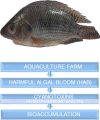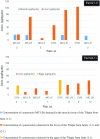Detection of freshwater cyanotoxins and measurement of masked microcystins in tilapia from Southeast Asian aquaculture farms
- PMID: 28429062
- PMCID: PMC5437195
- DOI: 10.1007/s00216-017-0352-4
Detection of freshwater cyanotoxins and measurement of masked microcystins in tilapia from Southeast Asian aquaculture farms
Abstract
Recently, there has been a rise in freshwater harmful algal blooms (HABs) globally, as well as increasing aquaculture practices. HABs can produce cyanotoxins, many of which are hepatotoxins. An ultra-performance liquid chromatography tandem mass spectrometry method was developed and validated for nine cyanotoxins across three classes including six microcystins, nodularin, cylindrospermopsin and anatoxin-a. The method was used to analyse free cyanotoxin(s) in muscle (n = 34), liver (n = 17) and egg (n = 9) tissue samples of 34 fish sourced from aquaculture farms in Southeast Asia. Conjugated microcystin was analysed by Lemieux oxidation to ascertain the total amount of microcystin present in muscle. Some tilapia accumulated free microcystin-LR in the muscle tissue at a mean of 15.45 μg/kg dry weight (dw), with total microcystin levels detected at a mean level of 110.1 μg/kg dw, indicating that the amount of conjugated or masked microcystin present in the fish muscle accounted for 85% of the total. Higher levels of cyanotoxin were detected in the livers, with approximately 60% of those tested being positive for microcystin-LR and microcystin-LF, along with cylindrospermopsin. Two fish from one of the aquaculture farms contained cylindrospermopsin in the eggs; the first time this has been reported. The estimated daily intake for free and total microcystins in fish muscle tissue was 2 and 14 times higher, respectively, than the tolerable daily intake value. This survey presents the requirement for further monitoring of cyanotoxins, including masked microcystins, in aquaculture farming in these regions and beyond, along with the implementation of guidelines to safeguard human health. Graphical abstract ᅟ.
Keywords: Aquaculture; Bioaccumulation; Harmful algal bloom; Human health; Microcystin; UPLC-MS/MS.
Conflict of interest statement
Conflict of interest
The authors declare that they have no conflict of interest.
Figures




Similar articles
-
A validated UPLC-MS/MS method for the surveillance of ten aquatic biotoxins in European brackish and freshwater systems.Harmful Algae. 2016 May;55:31-40. doi: 10.1016/j.hal.2016.01.006. Epub 2016 Feb 12. Harmful Algae. 2016. PMID: 28073545
-
Detection of various freshwater cyanobacterial toxins using ultra-performance liquid chromatography tandem mass spectrometry.Toxicon. 2010 May;55(5):965-72. doi: 10.1016/j.toxicon.2009.10.001. Epub 2009 Oct 28. Toxicon. 2010. PMID: 19878689
-
Detected cyanotoxins by UHPLC MS/MS technique in tropical reservoirs of northeastern Colombia.Toxicon. 2019 Sep;167:38-48. doi: 10.1016/j.toxicon.2019.06.010. Epub 2019 Jun 8. Toxicon. 2019. PMID: 31185239
-
Synthesis of ecotoxicological studies on cyanotoxins in freshwater habitats - Evaluating the basis for developing thresholds protective of aquatic life in the United States.Sci Total Environ. 2021 Nov 15;795:148864. doi: 10.1016/j.scitotenv.2021.148864. Epub 2021 Jul 3. Sci Total Environ. 2021. PMID: 34328929 Review.
-
Blue revolution turning green? A global concern of cyanobacteria and cyanotoxins in freshwater aquaculture: A literature review.J Environ Manage. 2024 Jun;360:121115. doi: 10.1016/j.jenvman.2024.121115. Epub 2024 May 14. J Environ Manage. 2024. PMID: 38749125 Review.
Cited by
-
Understanding the Risks of Diffusion of Cyanobacteria Toxins in Rivers, Lakes, and Potable Water.Toxins (Basel). 2023 Sep 20;15(9):582. doi: 10.3390/toxins15090582. Toxins (Basel). 2023. PMID: 37756009 Free PMC article. Review.
-
Development and Application of Extraction Methods for LC-MS Quantification of Microcystins in Liver Tissue.Toxins (Basel). 2020 Apr 19;12(4):263. doi: 10.3390/toxins12040263. Toxins (Basel). 2020. PMID: 32325806 Free PMC article.
-
Variability of Microcystin-LR Standards Available from Seven Commercial Vendors.Toxins (Basel). 2022 Oct 14;14(10):705. doi: 10.3390/toxins14100705. Toxins (Basel). 2022. PMID: 36287973 Free PMC article.
-
Metabolomics Applied to Cyanobacterial Toxins and Natural Products.Adv Exp Med Biol. 2023;1439:21-49. doi: 10.1007/978-3-031-41741-2_2. Adv Exp Med Biol. 2023. PMID: 37843804 Review.
-
Sensors, Biosensors, and Analytical Technologies for Aquaculture Water Quality.Research (Wash D C). 2020 Feb 17;2020:8272705. doi: 10.34133/2020/8272705. eCollection 2020. Research (Wash D C). 2020. PMID: 32149280 Free PMC article. Review.
References
-
- Codd GA, Morrison LF, Metcalf JS. Cyanobacterial toxins: risk management for health protection. Toxicol Appl Pharmacol. 2005 - PubMed
-
- van Apeldoorn ME, van Egmond HP, Speijers GJA, Bakker GJI. Toxins of cyanobacteria. Mol Nutr Food Res. 2007 - PubMed
-
- Roegner AF, Brena B, Gonzalez-Sapienza G, Puschner B. Microcystins in potable surface waters: toxic effects and removal strategies. J Appl Toxicol. 2014 - PubMed
-
- Greer B, McNamee SE, Boots B, Cimarelli L, Guillebault D, Helmi K, Marcheggiani S, Panaiotov S, Breitenbach U, Akcaalan R, Medlin LK, Kittler K, Elliott CT, Campbell K. A validated UPLC-MS/MS method for the surveillance of ten aquatic biotoxins in European brackish and freshwater systems. Harmful Algae. 2016 - PubMed
-
- Sivonen K, Jones G (1999) In: Chorus I, Bartram J (eds) Toxic cyanobacteria in water: a guide to their public health consequences, monitoring and management. Cyanobacterial toxins. E & FN Spon, WHO. 41–111.
Publication types
MeSH terms
Substances
LinkOut - more resources
Full Text Sources
Other Literature Sources

